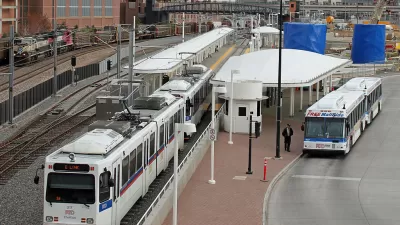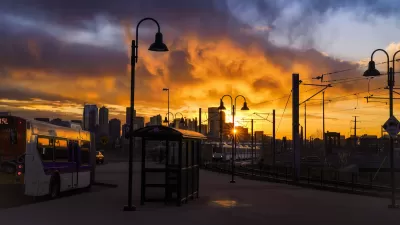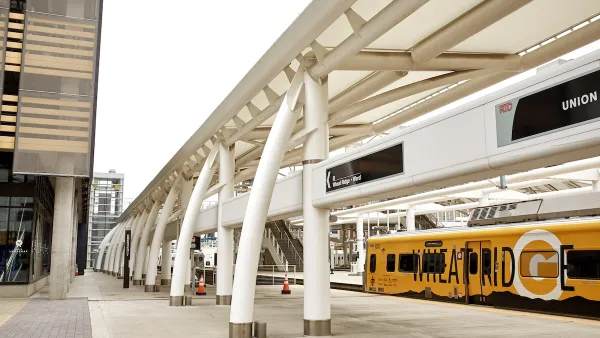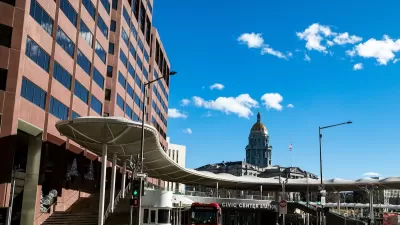The 10-mile Colfax Ave corridor has the city's highest bus ridership but plagued by traffic congestion. After a 2-year study, bus rapid transit with dedicated lanes was selected by city and county staff as part of a $115 million investment strategy.

"Bus Rapid Transit, or BRT, was picked over two other possibilities, including the so-called Modern Streetcar, after a two-year study of the snags along the East Colfax stretch," writes Monte Whaley of The Denver Post, though his paper's editorial board was quick to write, "Not so fast."
Already, there are nearly 7 million annual boardings on Regional Transportation District buses on Colfax, with more than 22,000 per weekday. It makes sense that a city-run bus system with new state-of-the-art stations and off-board ticket machines would thrive on that same stretch of roadway, officials say.
Crissy Fanganello, Denver Public Works transportation director, concurred. "Colfax serves as a critical backbone of the city's transportation network and has the highest bus ridership in RTD's system," said Fanganello. "BRT on Colfax will offer an upgraded, cost-effective transit experience that moves more people throughout the corridor, helping meet existing and future travel demand."
Key to the BRT are the dedicated lanes in order to overcome traffic congestion plaguing the line. Outside (toward the center) lanes, one is each direction, will be restricted to buses only in morning and evening peak commute hours as it "minimizes the potential problems of on-street parking," according to planners. Inside lanes presented potential problems with on-street parking.
"There is no doubt that congestion will continue to be a major issue unless something is done along the corridor," said Tykus Holloway, Denver's transportation project manager.
While BRT with the dedicated lanes, if only during peak hours, requires more study, it's significant that it beat out the other two options:
- "Modern Streetcar, which is comparable in time savings and ridership but would cost about $450 million, Denver planners said."
- "Enhanced buses, which are upgraded buses but without exclusive lanes."
Next step is preparing the environmental analysis for the selection, which pleased Whaley's editors, who wrote: "The thought of dedicating one lane in each direction solely to buses during rush hour in an already congested four-lane corridor is tough to swallow without more information."
FULL STORY: Colfax Avenue may get a new bus system to aid congestion

Planetizen Federal Action Tracker
A weekly monitor of how Trump’s orders and actions are impacting planners and planning in America.

Chicago’s Ghost Rails
Just beneath the surface of the modern city lie the remnants of its expansive early 20th-century streetcar system.

San Antonio and Austin are Fusing Into one Massive Megaregion
The region spanning the two central Texas cities is growing fast, posing challenges for local infrastructure and water supplies.

Since Zion's Shuttles Went Electric “The Smog is Gone”
Visitors to Zion National Park can enjoy the canyon via the nation’s first fully electric park shuttle system.

Trump Distributing DOT Safety Funds at 1/10 Rate of Biden
Funds for Safe Streets and other transportation safety and equity programs are being held up by administrative reviews and conflicts with the Trump administration’s priorities.

German Cities Subsidize Taxis for Women Amid Wave of Violence
Free or low-cost taxi rides can help women navigate cities more safely, but critics say the programs don't address the root causes of violence against women.
Urban Design for Planners 1: Software Tools
This six-course series explores essential urban design concepts using open source software and equips planners with the tools they need to participate fully in the urban design process.
Planning for Universal Design
Learn the tools for implementing Universal Design in planning regulations.
planning NEXT
Appalachian Highlands Housing Partners
Mpact (founded as Rail~Volution)
City of Camden Redevelopment Agency
City of Astoria
City of Portland
City of Laramie





























